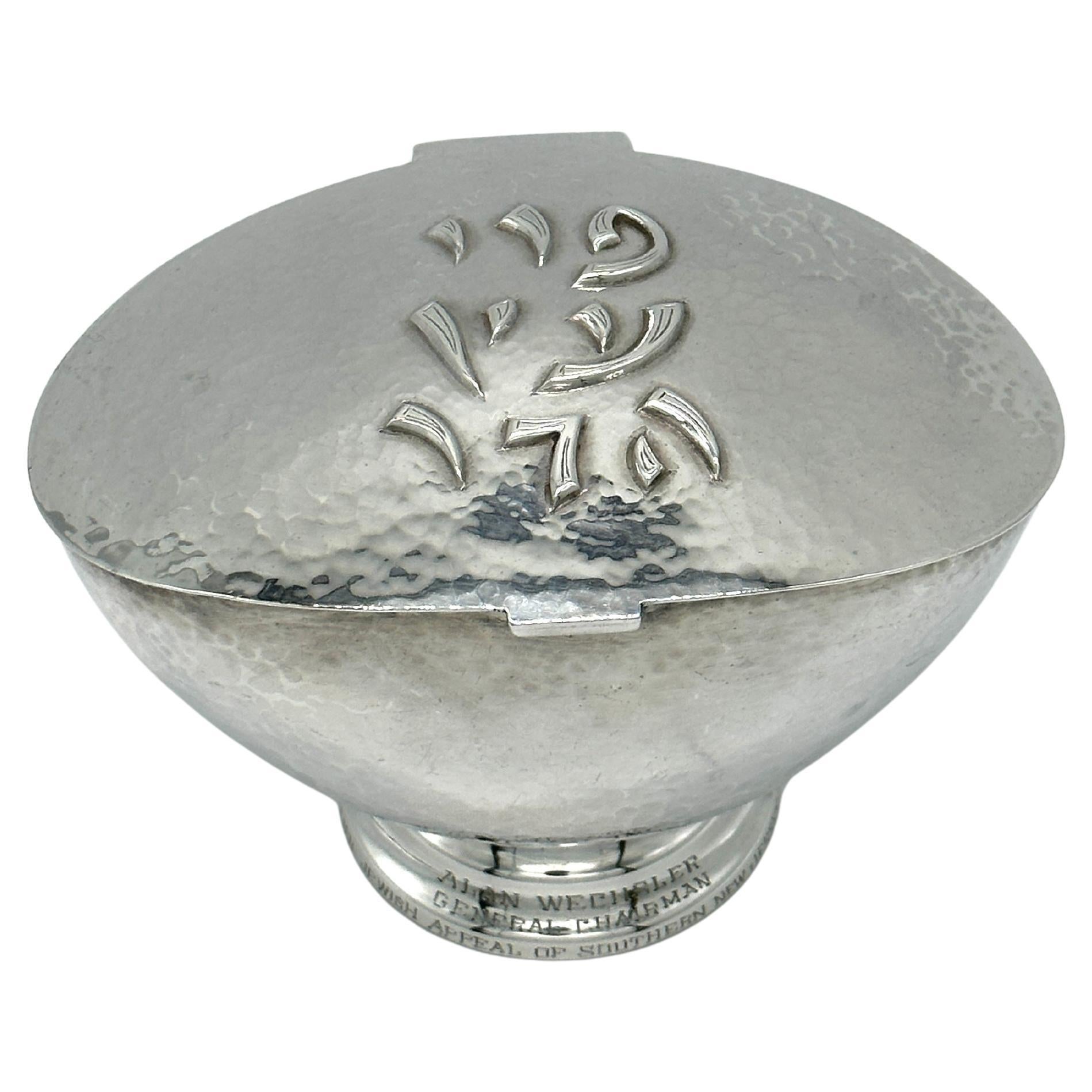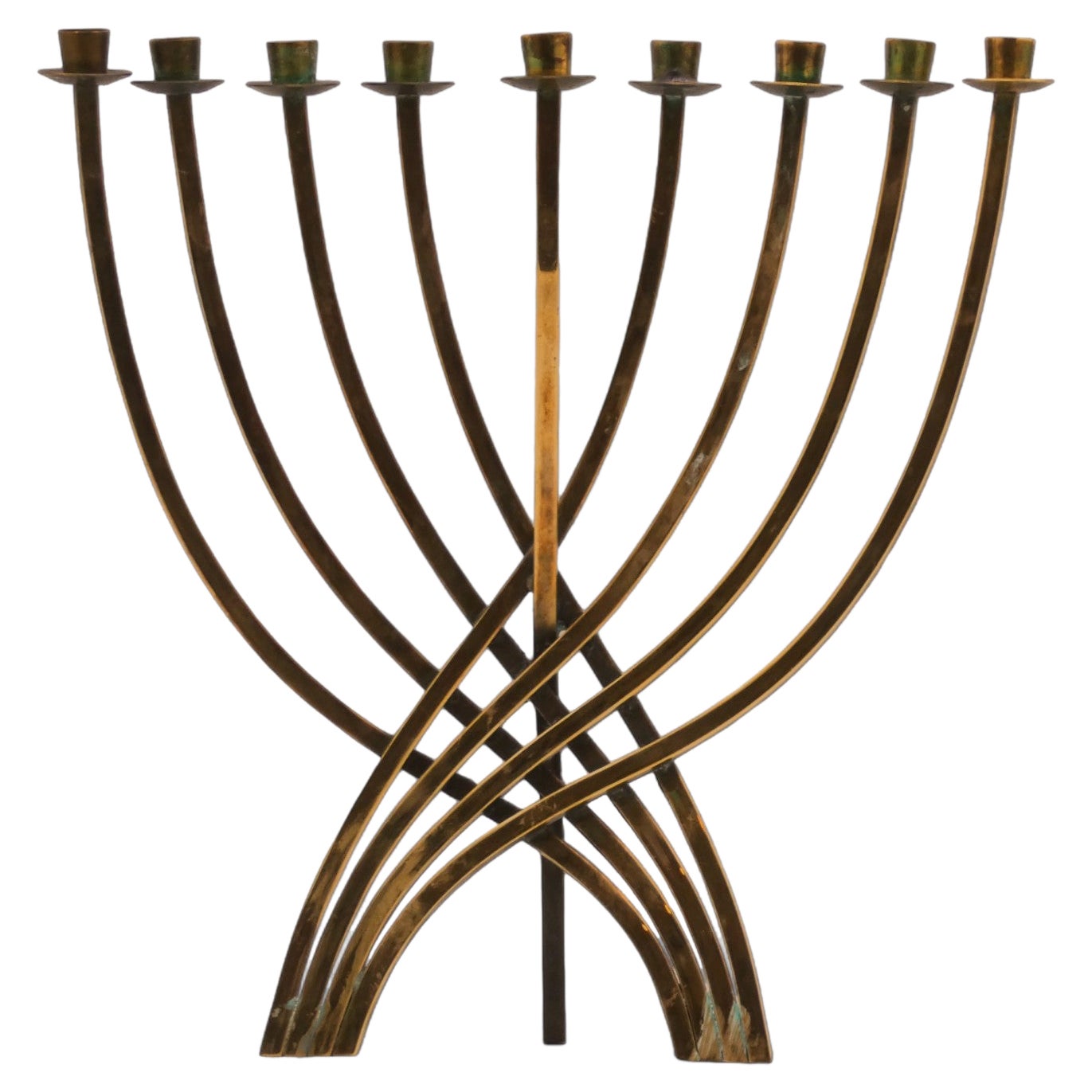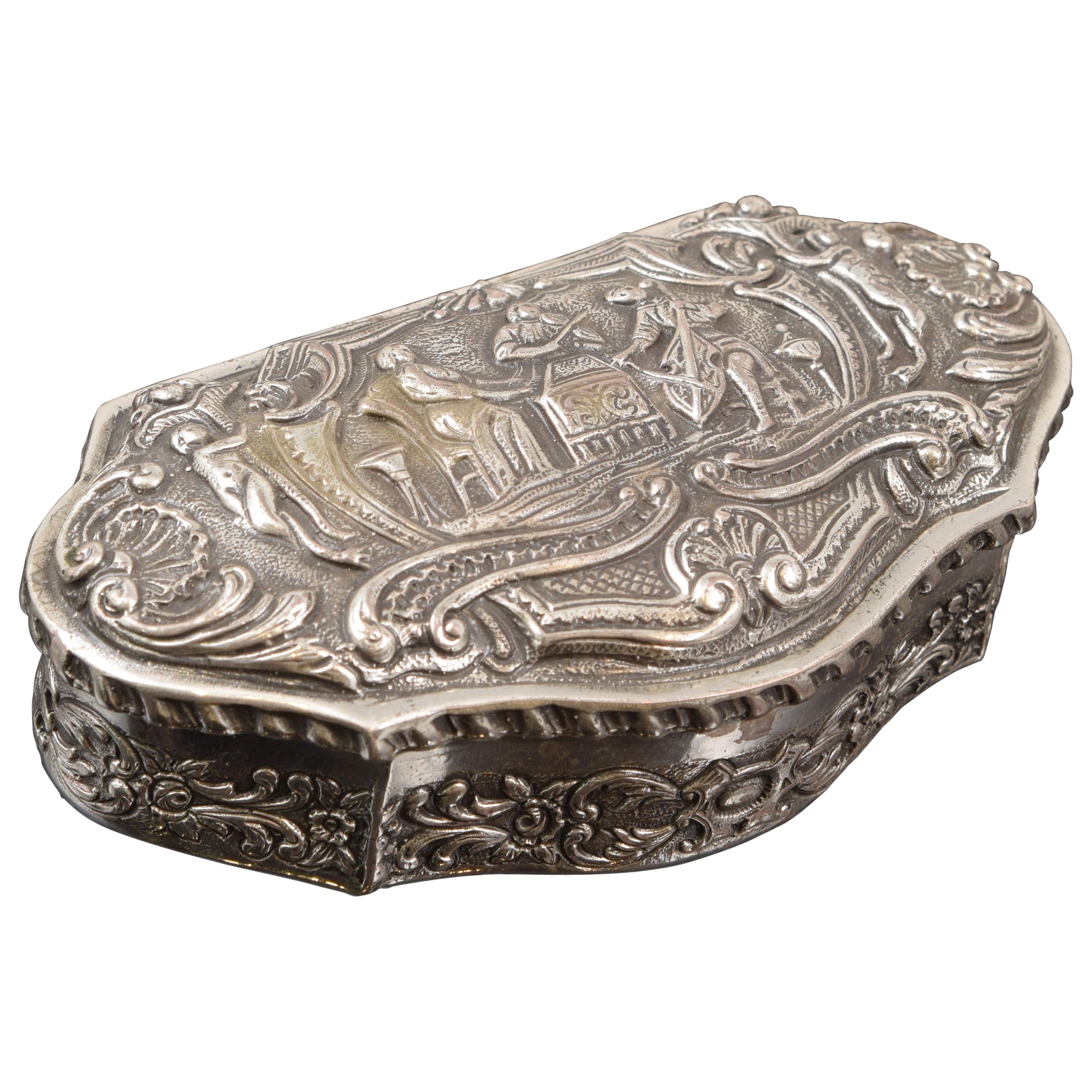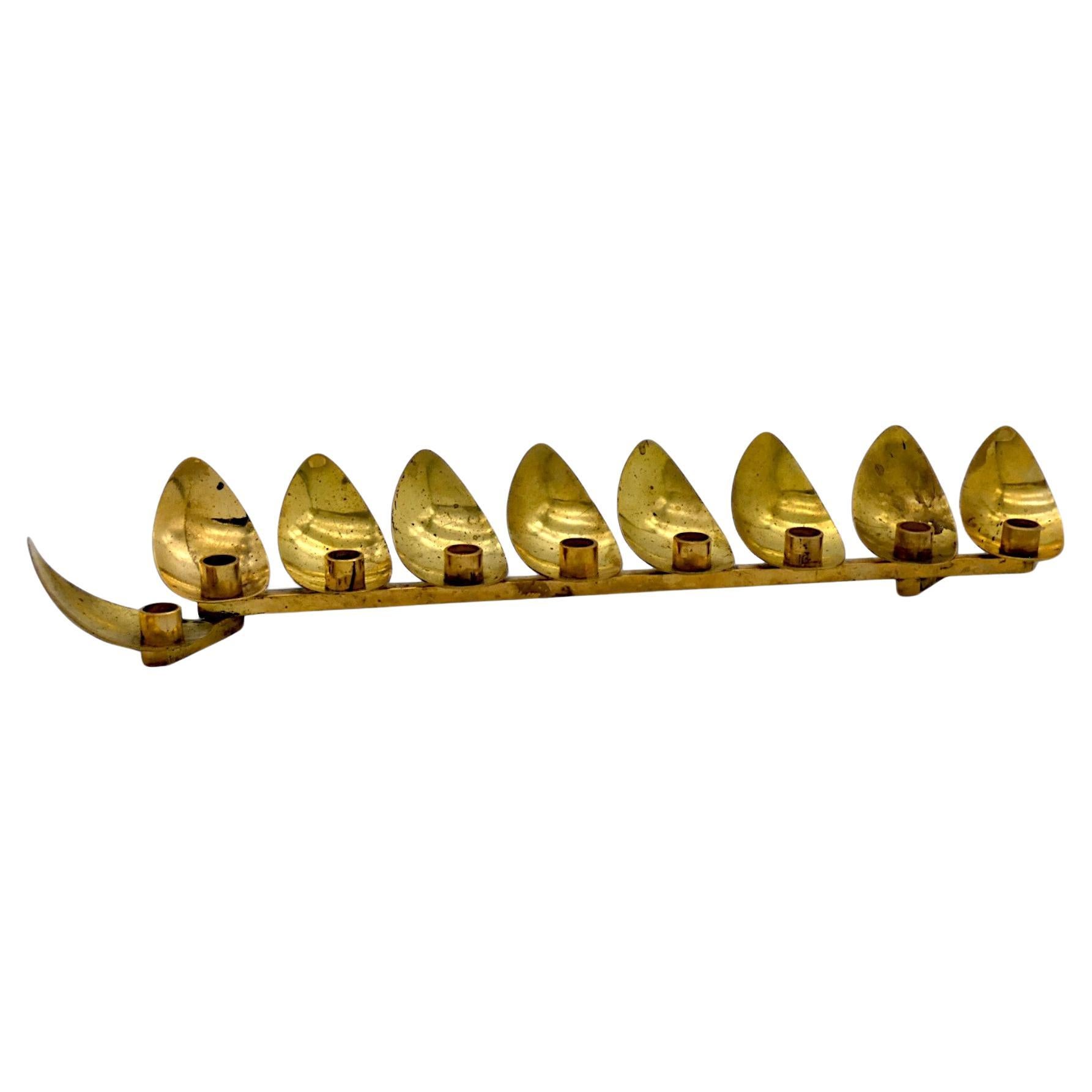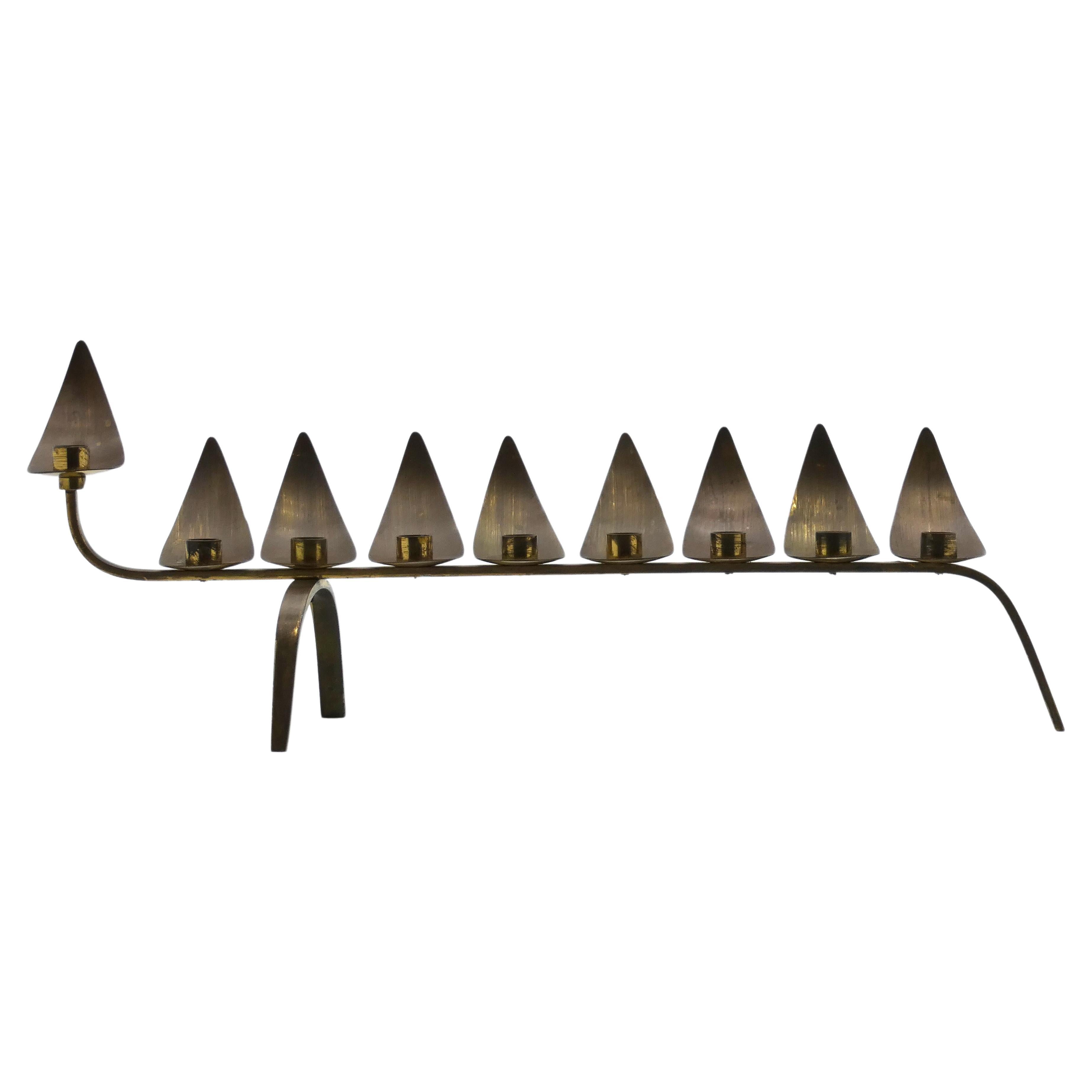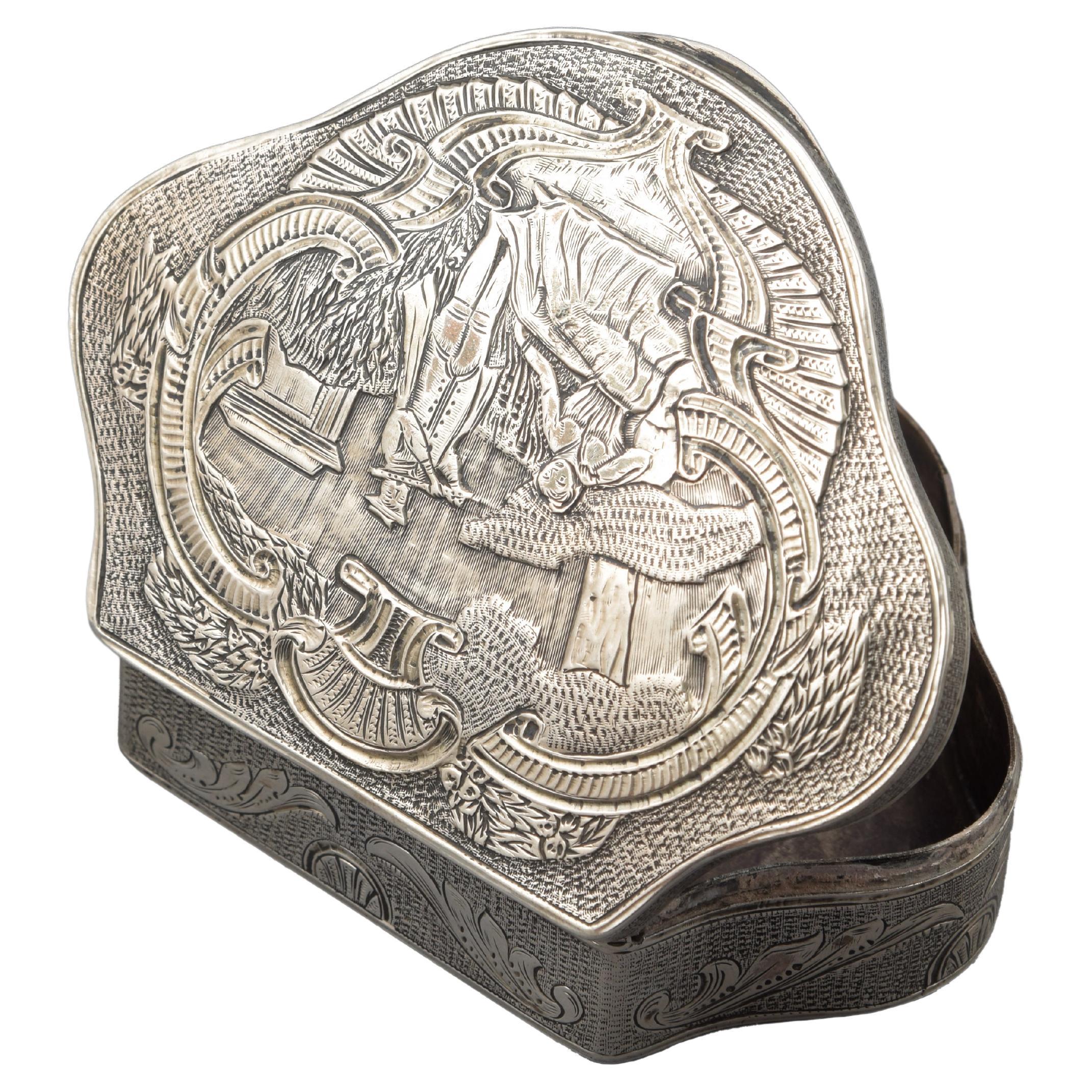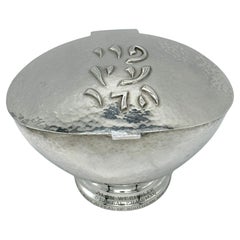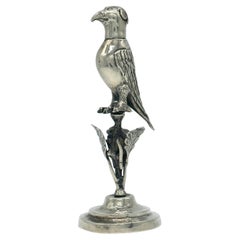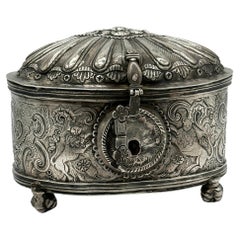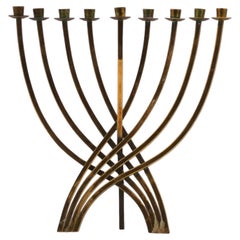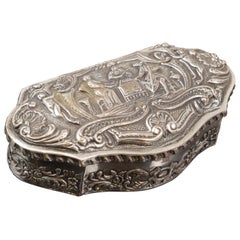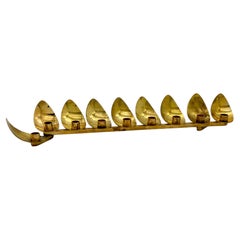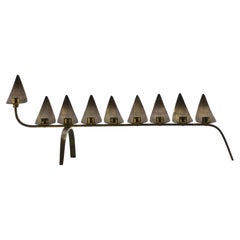Items Similar to JUDAICA SILVER ETROG BOX DESIGNED BY LUDWIG WOLPERT. New York, 20th century
Want more images or videos?
Request additional images or videos from the seller
1 of 21
JUDAICA SILVER ETROG BOX DESIGNED BY LUDWIG WOLPERT. New York, 20th century
$12,000per item
£9,099.58per item
€10,528.64per item
CA$16,962.44per item
A$18,909.86per item
CHF 9,862.27per item
MX$228,664.01per item
NOK 123,973.55per item
SEK 117,303.75per item
DKK 78,585.55per item
Quantity
About the Item
This charming piece of jewish history in front of you is a one of kind modern Judaica object, This box used to hold the Etrog To protect the it during the holiday of Sukkot, it is traditionally Wrapped in silky flax fibers and stored in a special decorative box, mostly made from silver. Wolpert designed this amazing hand hammered Bauhaus style box in 1963-1964 while he was Working in New York. all of the boxes we could found from this design made by Wolpert have The upper part inscribed in a simple engraving with the phrase "Pri Etz Hadar" In Hebrew ״פרי עץ הדר״. the box in front of you is the only example in existence as far as we Know where the letters are also repoussé and also engraved, such a beautiful and hard to get Combination, the rest of the box is shaped as a modernistic Etrog, all the body of the box is Skillfully hand hammered in a way it reflects the light in a warm and calm way, a true Masterpiece of modern judaica by the great and important artist Ludwig Yehuda Wolpert. One of the the two great masters of 20th century Judaica. the Box is marked "WOLPERT" AND "STERLING" and the base has the engraved inscription : "ALAN WECHSLER GENERAL CHAIRMAN, ALLIED JEWISH APPEAL OF SOUTHERN NEW JERSEY 1978"
Similar boxes can be find in museum collections around the world
In the Jewish Museum New York
In the North Carolina Museum of Art
In The Derfner Judaica Museum
Another similar box was featured in the Israel Museum exhibition "Forging Ahead, Wolpert and Gumbel, Israeli Silversmiths for the Modern Age"
sizes:
Height: 4 in (10.16 cm)
Width: 6.1 in (15.5 cm)
Depth: 4.4 in (11.18 cm)
Weight :
Ludwig Yehuda Wolpert was born in Hildesheim, Germany, to an Orthodox family. In 1916-1920, He began his studies in sculpture at the Frankfurt School of Art. In 1925-1928, he studied Goldsmithing at the Frankfurt School of Art. Following the presentation of the works in the 1930 exhibition "Kult und Form" ("Ritual and Form") at the Jewish Museum in Berlin, his works became well known in the German Jewish World. His works were greatly influenced by Modernist design, especially the Bauhaus Movement. Wolpert's works avoid decoration, relying on clean, geometric shapes. In 1933, Following the Nazi rise to power in Germany, he immigrated to the Mandatory Palestine with His family. There he worked for two years in the workshop of Bernhard Friedländer, where he Designed and produced silverware and Jewish ceremonial art.Together with Victor Solomon Reese] he made the sculpture "The Flying Camel", the symbol of the "Levant Fair", under the architect Aryeh Elhanani. In 1935 he began teaching at Bezalel Academy of Arts and Design in Jerusalem, where he Headed the Department of Metal together with jeweler David Heinz Gumbel. Wolpert placed An emphasis on the use of Hebrew calligraphy in Jewish ceremonial art. In addition to his Teaching, he continued to create modern Judaica at the school’s workshop. In 1942 he Established an independent workshop in Jerusalem. In 1956, Wolpert moved to the United States, where he headed the Tobe Pascher Workshop For Modern Jewish Art at the Jewish Museum in New York City.
Holding the Etrog in sukkot is one of the earliest known jewish festivals that are still celebrated Until today, we can find testimonials for this in the Bible and also on the book of Josephus, Antiquities of the Jews III 10.4, "Concerning the festivals; and how each day of such festival is To be observed" "But on the fifteenth day of the same month [Tishrei], when the season of the year is changing For winter, the law enjoins us to pitch tabernacles in every one of our houses; but so that we Preserve our selves from the cold of that time of the year: as also that when we should arrive At our own countrey, and come to that city which we should have then for our metropolis, Because of the temple therein to be built; and keep a festival for eight days; and offer burnt Offerings, and sacrifice thank offerings: that we should then carry in our hands a branch of Myrtle, and willow, and a bough of the palm-tree, with the addition of the pomecitron..."
- Creator:Ludwig Yehuda Wolpert (Artist)
- Dimensions:Height: 4 in (10.16 cm)Width: 6.1 in (15.5 cm)Depth: 4.4 in (11.18 cm)
- Style:Bauhaus (In the Style Of)
- Materials and Techniques:
- Place of Origin:
- Period:
- Date of Manufacture:1970
- Condition:Wear consistent with age and use. perfect original condition, some minor scratches consistent with use.
- Seller Location:Tel Aviv - Jaffa, IL
- Reference Number:1stDibs: LU8130246405132
About the Seller
No Reviews Yet
Vetted Professional Seller
Every seller passes strict standards for authenticity and reliability
1stDibs seller since 2023
- ShippingRetrieving quote...Shipping from: Tel Aviv - Jaffa, Israel
- Return Policy
Authenticity Guarantee
In the unlikely event there’s an issue with an item’s authenticity, contact us within 1 year for a full refund. DetailsMoney-Back Guarantee
If your item is not as described, is damaged in transit, or does not arrive, contact us within 7 days for a full refund. Details24-Hour Cancellation
You have a 24-hour grace period in which to reconsider your purchase, with no questions asked.Vetted Professional Sellers
Our world-class sellers must adhere to strict standards for service and quality, maintaining the integrity of our listings.Price-Match Guarantee
If you find that a seller listed the same item for a lower price elsewhere, we’ll match it.Trusted Global Delivery
Our best-in-class carrier network provides specialized shipping options worldwide, including custom delivery.More From This Seller
View AllJUDAICA SILVER ETROG BOX DESIGNED BY LUDWIG WOLPERT. New York, 20th century
Located in Tel Aviv - Jaffa, IL
This charming piece of jewish history in front of you is a one of kind modern Judaica object,
This box used to hold the Etrog To protect the it during the holiday of Sukkot, it is traditionally Wrapped in silky flax fibers and stored in a special decorative box, mostly made from silver.
Wolpert designed this amazing hand hammered Bauhaus style box in 1963-1964 while he was Working in New York. all of the boxes we could found from this design made by Wolpert have The upper part inscribed in a simple engraving with the phrase "Pri Etz Hadar"
In Hebrew ״פרי עץ הדר״. the box in front of you is the only example in existence as far as we Know where the letters are also repoussé and also engraved, such a beautiful and hard to get Combination, the rest of the box is shaped as a modernistic Etrog, all the body of the box is Skillfully hand hammered in a way it reflects the light in a warm and calm way, a true Masterpiece of modern judaica by the great and important artist Ludwig Yehuda Wolpert.
One of the the two great masters of 20th century Judaica.
the Box is marked "WOLPERT" AND "STERLING" and the base has the engraved inscription :
"ALAN WECHSLER GENERAL CHAIRMAN, ALLIED JEWISH APPEAL OF SOUTHERN NEW JERSEY 1978"
Similar boxes can be find in museum collections around the world
In the Jewish Museum New York
In the North Carolina Museum of Art
In The Derfner Judaica Museum
Another similar box was featured in the Israel Museum exhibition
"Forging Ahead, Wolpert and Gumbel, Israeli Silversmiths for the Modern Age"
Ludwig Yehuda Wolpert was born in Hildesheim, Germany, to an Orthodox family. In 1916-1920, He began his studies in sculpture at the Frankfurt School of Art. In 1925-1928, he studied Goldsmithing at the Frankfurt School of Art.
Following the presentation of the works in the 1930 exhibition "Kult und Form" ("Ritual and Form") at the Jewish Museum in Berlin, his works became well known in the German Jewish World. His works were greatly influenced by Modernist design, especially the Bauhaus Movement. Wolpert's works avoid decoration, relying on clean, geometric shapes. In 1933, Following the Nazi rise to power in Germany, he immigrated to the Mandatory Palestine with His family. There he worked for two years in the workshop of Bernhard Friedländer, where he Designed and produced silverware and Jewish ceremonial art.Together with Victor Solomon...
Category
Vintage 1960s Decorative Boxes
Materials
Silver
RARE Austrian silver (ALT WIEN) Havdalah spice container, Judaica ISRAEL MUSEUM
Located in Tel Aviv - Jaffa, IL
Up for sale is this museum quality Judaica Havdalah spice container, very rare with great provenance!!
This silver spice tower was made in Vienna Austria, on the early part of the 19...
Category
Antique Early 1800s Snuff Boxes and Tobacco Boxes
Materials
Silver
extremely rare Algerian Judaica silver, jewish Dowry box early 19th century
Located in Tel Aviv - Jaffa, IL
Amazing and scarce JUDAICA object, we have here one of the most touching jewish objects we had for a long time, this small silver dowry box was made in Algeria in the early 19th century, it is all covered with symbols of jewish faith and of couples, the sliding lid has 2 flanking birds with hamsa (protective hand) on each side and a flower vase in the middle.
one side shows two flanking lions with a tree in the middle and the other side shows again two big and two small birds with a flower bowl in the middle, front side has a key hole and next to it there is the Hebrew inscription ס״ט״" which says Siman tov or in English "a good sign" it is taken from the wedding blessing, underneath the lock there is another inscription with the name ״עזיזה בת אברהם בן חמו״ which is the name of the bride, her father and her grandfathers name.
the box is full marked a lot of times with the silversmith mark, every side of the box is marked.
this box was probably ordered by the grooms family to hold the jewelry they are giving to the bride as dowry, this type of objects are rare and there are just a few of them on museum collections.
DOWRY (Heb. נְדֻנְיָה), the property a wife brings to her husband at marriage; the Yiddish equivalent, nadn, is from the same root. The custom of nedunyah became clearly defined and institutionalized only in the talmudic period. In biblical times, mohar (מֹהַר), whereby the groom bought his wife from her father (Gen. 24:53; Ex. 22:15–16; Hos. 3:2), was the accepted practice. It was then customary that the groom give the bride gifts, and that she bring certain property to her husband's home upon marriage: slaves, cattle, real estate, etc. (cf. Gen. 24:59–61; 29; Judg. 1:14ff.; I Kings 9:16). Evidence of the custom of nedunyah is to be found in Tobit (7:14; 8:21) and in the Assuan papyri (Cowley, Aramaic, nos. 15, 18). Gradually, mohar was superseded by the ketubbah custom according to which the husband merely assumed the responsibility of compensation to his wife in case he divorced her: he had to pay her 200 zuzim if she had been a virgin at the time of marriage, and 100 zuzim if a widow or divorcée (see *Ketubbah).
By talmudic times, the institution of nedunyah was prevalent; the father gave a dowry to the bride since the daughter was excluded from paternal inheritance. Fifty zuzim (equivalent to the worth of 180 grams of silver) was the minimum amount a father was obliged to give to his daughter (Ket. 6:5). Parents usually gave much more, according to their social standing. Community funds provided the dowry for an orphan or a very poor girl (ibid.; cf. Sh. Ar., YD 251:8). In case of her father's death, the brothers of a minor girl were obliged to give her the minimum dowry, and the court estimated how much her father would have given her above the minimum dowry. The sum was then taken out of the father's estate and given to the daughter upon majority (Ket. 6:6; 68a–69b). In the absence of such an estimate, each daughter was entitled to receive one-tenth of the value of her father's estate in money, or in valuables (Yad, Ishut, 20:4–7; Sh. Ar., EH 113:4). If the father was unable or unwilling to pay the promised dowry at the betrothal ceremony, the groom could refuse to marry his bride (Ket. 13:5; Ket. 108b–109a). Insistence on exact payment of the promised dowry, however, was frowned upon by later rabbinic authorities (Rema to Sh. Ar., EH 2:1). In certain communities it was customary for the groom's father to make a dowry contribution equal to that of the bride's father (Ket. 102b). The dowry, whether given in real estate, slaves, money, or chattel was recorded in the marriage contract (the ketubbah) and in some instances one-third or one-fifth of the actual value of the dowry was added to the sum mentioned in the ketubbah. Based upon a decree enacted by *Simeon b. Shetah (first century C.E.), the Talmud ruled that the husband and his entire property were liable for compensation as stipulated in the ketubbah, either in case he died (when she collected the sum specified in the ketubbah from the heirs) or in case he divorced his wife (Ket. 82b). For the status of the dowry and the husband's rights and obligations, see below. The rabbinic enactments (Takkanot Shum) by R. Jacob *Tam and by the rabbinic synod of the communities of Speyer, Worms, and Mainz (Germany) stipulated that if a woman died...
Category
Antique Mid-19th Century Algerian Tribal Art
Materials
Silver
Rare silver Herb Box (Yerbera), Upper Peru, Potosí, c. 1775–90 great repoussé
Located in Tel Aviv - Jaffa, IL
Herb Box (Yerbera), Upper Peru, possibly Potosí, c. 1775–90, cast, repoussé, and chased silver,
the design is very intricate, with lions, cats and some other animals, and a women on the lid, it is made in a shell shape with a classical women on top of the lid, the body is all hand made with lions and wild cats with leafs designs, the inner part is divided into two compartments, as usually in this type of boxes. lock is not working but it is very nice and "primitive" looking.
Boxes have a long history across cultures and time. In Spanish America, containers of many types, styles, and materials were cherished as gifts. Known today as yerberas (herb boxes) or coqueras (coca boxes...
Category
Antique Late 18th Century Snuff Boxes and Tobacco Boxes
Materials
Silver
An Israeli sterling Silver Tzedakah box, Judaica, by Carmel Shabi, 1994
Located in Tel Aviv - Jaffa, IL
Tzedakah box of flattened oviform shape (round fish shape) , amazing sleek and Modernistic design. just a masterpiece of design.
Pierced with stylized H...
Category
1990s Sterling Silver
Materials
Silver
Important Early 20th Century Silver Kiddush cup by Bezalel School Jerusalem
Located in Tel Aviv - Jaffa, IL
Important Handmade sterling silver Kiddush goblet by Bezalel School, Jerusalem, Circa 1910-1913.
On the cup there are 3 identical scenes of flanked lions and on the middle of them There are two columns with a staircase, this design is probably taken from Eastern European torah ark, on the middle part there is a chandelier with 3 tiger/lioness Heads, the top of the cup has 3 inscription on top of each flanking lions scene, first One says : ״כוס ישועות אשא״ (Psalms 116:13) which means " I will take the cup of Salvation", this is a rather common blessing on kiddush cups.
Next inscription says : ״אין שמחה אלא ביין״ in English " there is no joy except in wine" This says that after the temple was destroyed we have our joy only in the wine of Kiddish.
The last inscription says ״ושמחת בחגך״ (Deuteronomy 16:14 ) in English : "And you shall rejoice in your festival".
So this cup is a kiddish cup...
Category
Vintage 1910s Israeli Art Nouveau Sterling Silver
Materials
Silver
You May Also Like
A Brass Menorah By Ludwig Wolpert
By Ludwig Yehuda Wolpert
Located in New York, NY
Brass Menorah by Ludwig Yehuda Wolpert is a reproduction of a minimalist branch menorah with a Bauhaus styling designed by Ludwig Yehuda Wolpert.
Menorah is made up of nine long squ...
Category
Mid-20th Century Israeli Bauhaus Candelabras
Materials
Brass
$1,840 Sale Price
71% Off
Carved Silver Box, 20th Century
Located in Madrid, ES
Carved silver box, 20th century.
Small silver box carved with a great variety of motifs, all belonging to different artistic traditions based on Ro...
Category
20th Century European Rococo Revival Decorative Boxes
Materials
Silver
A Brass Hanukkah Lamp by Ludwig Wolpert
By Ludwig Yehuda Wolpert
Located in New York, NY
A Brass Art Deco Hanukkah Lamp by Ludwig Wolpert made in Israel in the 1960s.
Classic Art Deco design using geometric shapes which were used in that period to make artistic creation...
Category
Mid-20th Century Israeli Candle Lamps
Materials
Brass
$2,000 Sale Price
20% Off
A Brass Hanukkah Lamp by Ludwig Wolpert
By Ludwig Yehuda Wolpert
Located in New York, NY
Classic Hanukkah lamp designed by Ludwig Yehuda Wolpert in the 20th century.
This Hannukah lamp is elegantly designed with two thin curved bars crossed at one end which serve as the three legs it stands on.
Eight small cylindrical cups are neatly fitted with bobeches formed as flaring wicks behind them and placed in a straight row along the longer upper bar.
The upper bar is interestingly raised at one end to hold the servant lamp which is designed similarly to the other in a cylindrical and flamed fashion...
Category
20th Century Israeli Art Deco Candle Lamps
Materials
Brass
$2,000 Sale Price
69% Off
Silver Box, 19th-20th Century
Located in Madrid, ES
With hallmarks.
Three-lobed flat-top box made of silver in its color decorated on the edge and lid with elements on chopped luster. The upper part presents a scene framed by scallop...
Category
Early 20th Century European Neoclassical Decorative Boxes
Materials
Silver
Sterling Etrog Box
Located in Brooklyn, NY
Etrog is the yellow citron or Citrus medica used by Jewish people during the week-long holiday of Sukkot, as one of the four species. Together with a lulav, hadass and aravah, the etrog is to be taken in each hand. To protect the etrog during the holiday, it is traditionally wrapped in silky flax fibers and stored in a special box, often made from silver. Smooth and without any decoration, this sterling silver etrog box...
Category
Vintage 1970s Italian Sterling Silver
Materials
Sterling Silver
$1,125
